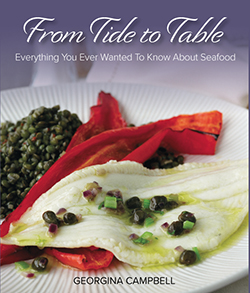Cookery Feature - JIBRIN - Celebrating the Food of Palestine
 Much-loved Cork residents, the Palestinian couple Izzeddeen Alkarajeh (a computer scientist) and his wife Eman Aburabi (an interior designer) first came to Ireland as asylum seekers with their four children in 2016. Following time in Direct Provision, they settled and started trading at Mahon Point Farmers' Market, where the tastes of their homeland - inmanaeesh za'atar (flatbread), hummus and moutabal - were an instant hit, selling out in just 2 hours on the first day. The success of their farmers’ market stall encouraged this wonderful pair to go further and open a café – and just a year later, in 2019, that became a reality with the opening of Izz Café on George’s Quay in Cork city.
Much-loved Cork residents, the Palestinian couple Izzeddeen Alkarajeh (a computer scientist) and his wife Eman Aburabi (an interior designer) first came to Ireland as asylum seekers with their four children in 2016. Following time in Direct Provision, they settled and started trading at Mahon Point Farmers' Market, where the tastes of their homeland - inmanaeesh za'atar (flatbread), hummus and moutabal - were an instant hit, selling out in just 2 hours on the first day. The success of their farmers’ market stall encouraged this wonderful pair to go further and open a café – and just a year later, in 2019, that became a reality with the opening of Izz Café on George’s Quay in Cork city.
Both have a great love of food and the way that it brings communities together, and the wonderful dishes – and coffee – that they brought from their homeland found a ready market. So their delightful Izz Café overlooking the River Lee soon became a Cork staple, and a place where Palestinian cuisine, culture and hospitality could be shared with all.
 And now, bringing excitement and delight in equal measure, the publication of their cookbook 'JIBRIN' has allowed them to share many of the Izz Café favourites for fans to enjoy at home. Named, poignantly, for their now abandoned family homeland, Beit Jibrin in Palestine, it is published by Blasta Books and can be bought online or in good book shops and speciality food stores.
And now, bringing excitement and delight in equal measure, the publication of their cookbook 'JIBRIN' has allowed them to share many of the Izz Café favourites for fans to enjoy at home. Named, poignantly, for their now abandoned family homeland, Beit Jibrin in Palestine, it is published by Blasta Books and can be bought online or in good book shops and speciality food stores.
BLASTA BOOKS #15: JIBRIN, by Izzeddeen Alkarajeh and Eman Aburabi £15/€17 RRP
RECIPES from JIBRIN to try:
.jpg) FATTOUSH
FATTOUSH
Popular across Palestine, Lebanon, Syria, Jordan and beyond, fattoush is a mezze staple. Sumac gives it a signature zing, while toasted or fried pitta highlights the region’s resourcefulness. This dish reflects communal dining traditions and a love for seasonal produce. When we have friends over for dinner, we always serve fattoush, as it goes well with everything.
SERVES 4–6
4 tomatoes, diced
2 cucumbers, diced
1 green pepper, diced
1 red onion, finely diced (optional)
6 radishes, thinly sliced
1 head of romaine, chopped
a handful of rocket leaves
1 bunch of fresh mint, small leaves only
2 pittas
FOR THE DRESSING:
60ml (¼ cup) olive oil
juice of 2 lemons
1 garlic clove, minced
2 tbsp sumac, plus extra to garnish
2 tbsp pomegranate molasses
1 tsp salt
½ tsp ground black pepper or a pinch of
chilli flakes (optional)
TO GARNISH:
pomegranate seeds
1 lemon, cut into wedges or thinly sliced
Combine all the vegetables, romaine, rocket and fresh mint in a large salad bowl. We only use the smallest mint leaves so that they can be left whole, as cutting them changes their colour.
To make the dressing, whisk together the olive oil, lemon juice, garlic, sumac, pomegranate, molasses, salt and the black pepper or chilli flakes (if using).
Toast the pitta in the oven or on a hot pan until golden and crisp, then cut it into bite-sized pieces. Or for an extra treat, cut the pitta into small pieces and deep-fry it.
Pour the dressing over the vegetables and leaves, then toss gently to coat evenly.
Add the toasted pitta pieces on top just before serving to keep their crunch, then garnish with pomegranate seeds, an extra pinch of sumac and lemon wedges or slices. Enjoy immediately as a refreshing side dish.
.jpg) HUMMUS
HUMMUS
Hummus is the creamy Levantine dip made by blending chickpeas, tahini, olive oil, lemon juice and garlic. With roots spanning centuries, hummus is a staple in Middle Eastern cuisine, shared across Syria, Jordan, Palestine, Lebanon and beyond. Often served as part of a mezze spread, it symbolises communal dining and hospitality. Each region has its own twist – extra garlic, more lemon or added toppings – yet the essence remains a symbol of heritage and togetherness. MAKES APPROX. 500g (1lb 2oz)
360g (1½ cups) dried chickpeas or 2 x 400g (14oz) tins of chickpeas
½–2 tsp baking soda
2 garlic cloves, peeled (optional)
60ml (¼ cup) freshly squeezed lemon juice (about 1 large lemon)
3 tbsp tahini
3 tbsp extra-virgin olive oil, plus extra to garnish
1 tsp salt
a few ice cubes
TO GARNISH:
a pinch of paprika
a pinch of sumac
chopped fresh parsley
reserved whole cooked chickpeas
TO SERVE:
warm pitta (a recipe for homemade flatbread is given in Jibrin)
fresh vegetables
pickles
If you’re using dried chickpeas, soak them overnight in plenty of cold water with 1 teaspoon of baking soda. The next day, drain and rinse the chickpeas. Put them in a large saucepan and cover with cold water, then add another teaspoon of baking soda. Bring to a boil, then reduce the heat and simmer, uncovered, for 1–1½ hours, until very tender, but reserve a few whole chickpeas for garnish before they become too soft. We cook the chickpeas so long that they completely break down. We also don’t bother to skim off the froth that rises to the top of the pan, but you can if you like. Drain and allow to cool. If using tinned chickpeas, drain and rinse thoroughly. Put them in a large saucepan, cover with cold water and add ½ teaspoon baking soda to soften them further. Bring to a boil, then reduce the heat and simmer for 15 minutes. Drain and allow to cool. Put the cooled chickpeas in a food processor with the garlic (if using), lemon juice, tahini, oil, salt and a few ice cubes. Traditionally, garlic is essential in hummus, but we stopped adding it to our hummus in the café because our customers found it to be too strong. The ice gives the hummus a paler colour and also makes it softer and smoother. Blend until smooth and creamy, but you’ll never get it perfectly smooth when you make it at home because domestic blenders aren’t as powerful as the industrial one we have in the café. Taste and adjust with more salt or lemon juice if needed. Add a little water for a thinner consistency. Spread the hummus onto a serving plate or in a bowl, creating swirls with the back of a spoon. Drizzle generously with olive oil and garnish with paprika, sumac, chopped fresh parsley and the reserved whole chickpeas. Serve with warm pitta, fresh vegetables and pickles.
TRY THIS: We serve three types of hummus in the café: plain, beetroot and avocado.
To make beetroot hummus, just add an almost equal weight of roasted beetroot to the chickpeas.
To make avocado hummus, add an equal weight of peeled, stoned avocados to the chickpeas.
.jpg) NABULSI KNAFEH
NABULSI KNAFEH
Nabulsi knafeh is a sweet, cheesy pastry layered with kataifi pastry, then soaked in aromatic sugar syrup. This dessert is from Nablus in Palestine and is a festive favourite for special occasions. The story goes that one of the caliphs was depressed and asked his chef to come up with something to impress him, and this was the result. Serves 10
200g Nabulsi or Akkawi cheese, diced small, or grated mozzarella
500g frozen kataifi pastry
225g ghee or unsalted butter, melted, plus extra for greasing
2 tsp caster sugar
FOR THE SYRUP:
400g caster sugar
240ml water
1 tbsp freshly squeezed lemon juice
1 tsp rosewater or orange blossom water (optional)
TO DECORATE: finely chopped pistachios
Method
The Nabulsi or Akkawi cheese needs to have the salt removed, so put the diced cheese in a bowl, cover with cold water and soak for 15 minutes, then drain. Repeat this process every 15 minutes for 4 hours to remove the salt. Squeeze the diced cheese into even smaller pieces and set aside. Skip these steps if you're using grated mozzarella.
Preheat the oven to 180°C/Gas Mark 4. This works best in a conventional oven, using the top and bottom heat. Grease a 30.5cm cake tin generously with melted ghee or butter. Knafeh is traditionally made in a copper tray because it conducts the heat so well, but this will work too.
Chop the frozen kataifi pastry into small pieces to make it easier to blend. Add it in batches to a food processor and pulse until it's a fine powder.
Put the pastry in a large bowl with most of the melted ghee or butter and the sugar. Use your hands to combine into a dough. Add more ghee or butter if needed to bring it together – it should hold together when you squeeze it.
Spread half of the dough over the base of the greased tin, making sure there are no gaps and pressing it down in a firm, even layer.
Scatter the cheese over the pastry base, keeping the edges clear. Scatter the rest of the dough on top, pressing it gently to flatten the surface.
Bake in the preheated oven for 35-40 minutes, until the cheese has melted and the top is golden and crisp.
Meanwhile, to make the syrup, put the sugar, water and lemon juice in a saucepan and bring to a boil, then reduce the heat and simmer for about 10 minutes, stirring to dissolve the sugar, until thickened. Stir in the rosewater or orange blossom water (if using). Set aside to cool.
Remove the knafeh from the oven and immediately pour the cooled syrup over it, then scatter over the pistachios to decorate. Let it soak for 10-15 minutes before serving.





There are currently no comments
Leave a comment
Not a member? Register for your free membership now!
Or leave a comment by logging in with: